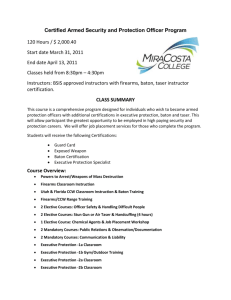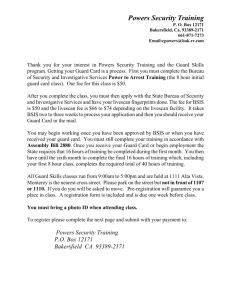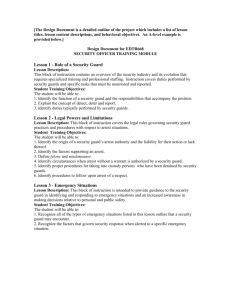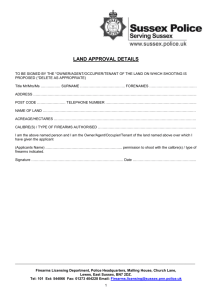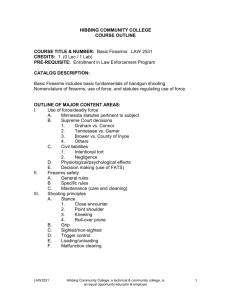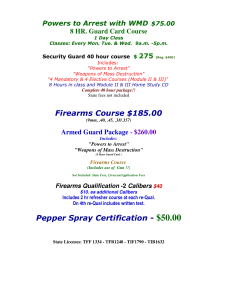Certified Armed Protection Specialist (CAPS) Program 127 Hours
advertisement
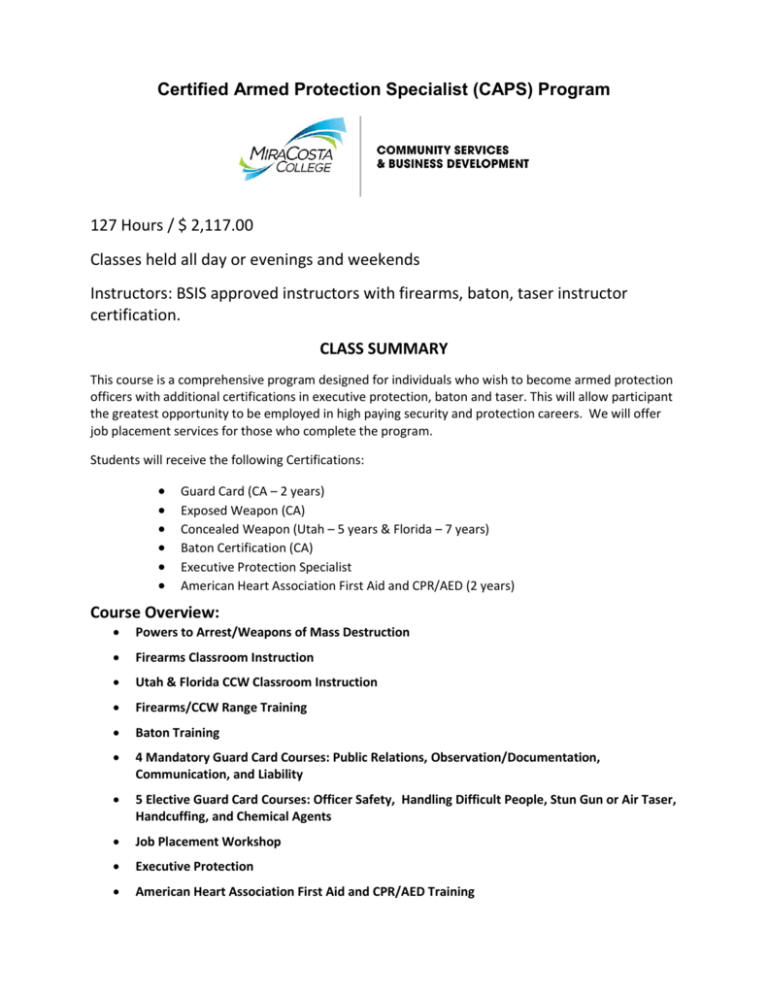
Certified Armed Protection Specialist (CAPS) Program 127 Hours / $ 2,117.00 Classes held all day or evenings and weekends Instructors: BSIS approved instructors with firearms, baton, taser instructor certification. CLASS SUMMARY This course is a comprehensive program designed for individuals who wish to become armed protection officers with additional certifications in executive protection, baton and taser. This will allow participant the greatest opportunity to be employed in high paying security and protection careers. We will offer job placement services for those who complete the program. Students will receive the following Certifications: Guard Card (CA – 2 years) Exposed Weapon (CA) Concealed Weapon (Utah – 5 years & Florida – 7 years) Baton Certification (CA) Executive Protection Specialist American Heart Association First Aid and CPR/AED (2 years) Course Overview: Powers to Arrest/Weapons of Mass Destruction Firearms Classroom Instruction Utah & Florida CCW Classroom Instruction Firearms/CCW Range Training Baton Training 4 Mandatory Guard Card Courses: Public Relations, Observation/Documentation, Communication, and Liability 5 Elective Guard Card Courses: Officer Safety, Handling Difficult People, Stun Gun or Air Taser, Handcuffing, and Chemical Agents Job Placement Workshop Executive Protection American Heart Association First Aid and CPR/AED Training POWER TO ARREST OUTLINE Objective: The Power to Arrest Course consists of eight (8) hours of training and the course will consist of lecture, discussions, exercises and role-playing. Pursuant to Business and Professions Code Section 7583.7(a) the following outline includes specific subjects that shall be taught in addition to follow-up mandatory courses to be completed within the first (30) days and elective courses to be completed within the first six (6) months respectively from the day the guard registration card is issued. A. Training 1. Overview of Power to Arrest Manual and subject matter. 2. Definition of arrest and discussion on the implications to the subject, the guard and the company. 3. Lecture/discussion on escalation and de-escalation techniques in the use of force, including role-playing and/or exercises. 4. Exercises in the use of restraint techniques and their implications. 5. Discussion of trespass laws and implications of enforcement, including role-playing in the proper application of trespass laws. 6. Completion of the Power to Arrest Training Manual Test with 100% score in accordance with the Manual’s Administering Instructions. RESPONSIBILITIES OF THE GUARD: A. Role and Responsibilities of the Security Guard 1. Areas of Responsibility 2. Prevention 3. Observe and Report 4. Get Help B. Relations with the Local Police C. Observation and Report Writing D. Authority to Question and a Basis for Making Decisions E. Inspections F. Legal Responsibilities and Liabilities G. Factors to Consider Before Making an Arrest H. Arrestable Offenses I. Private Person’s Arrest J. Making an Arrest K. Searching the suspect Illustration of the Frisk L. Merchant’s Privilege Search M. After the Arrest N. Terrorism O. Ethics and Professional Conduct of a Security Guard P. Answers to Study Questions Q. Final Examination ADDITIONAL TRAINING FOR SECURITY GUARDS COURSES OUTLINE Objective: To familiarize and instruct the individual on basic skills and provide a common body of knowledge in the performance of guard work. Two of the mandatory (8 hours) courses shall be completed within (30) days from the day the guard registration card is issued. MANDATORY COURSES: A. Public Relations (Community & Customer) 1. Gender & Racial Harassment & Discrimination 2. Respect: Stereotyping Attitude 3. Verbal skills / Crisis Intervention 4. Cultural Diversity 5. Substance abuse & Mental Illness 6. Ethics & Professionalism Appearance Command Presence Proper Conduct B. Observation & Documentation 1. Report Writing 2. English as a Second Language 3. Observation and Patrol Techniques 4. Asking Appropriate Questions 5. Observing Suspects / Suspicious Activity C. Communication and its Significance 1. Internal Protocols Pursuant to Contract (Who to Contact & When) Radio/Monitors Other Technology 2. External Emergency/First Responders Medical Personnel Police/Sheriff/Other Enforcement D. Liability/Legal Aspects 1. Personal/Contractor/Employer 2. Criminal, Civil, Administrative 3. BSIS Code & Regulations 4. Role of a Security Guard ELECTIVE COURSES: A. Officer Safety 1. Threat Assessment 2. Subject Contact 3. Safety Awareness 4. Blood Borne Pathogens 5. Environmental/Hazardous Materials B. Handling Difficult People C. D. E. F. G. 1. Communications 2. Conflict Management 3. Speaking Constructively 4. Valuing Diversity 5. Negotiating 6. Verbal Diffusion Chemical Agents 1. Tear Gas Use and Effects 2. Pepper Spray Use and Effects 3. Air Borne Chemical Agents 4. Water Borne Chemical Agents BSIS’s Certified Course in Baton Training Course in the Use of Handcuffs Course in the Use of a Stun Gun or Air Taser Heartsaver First Aid with CPR & AED 1. Recognize and care for breathing and cardiac emergencies in adults, children and infants 2. Perform one-and two-rescuer CPR 3. Use a resuscitation mask 4. Use an AED for victims of sudden cardiac arrest 5. Handle common first aid emergencies FIREARMS TRAINING SYLLABUS INTRODUCTION: I. REGISTRATION A. Administration 1. Check Individual Identification 2. Check guard registration status 3. Have state forms filled out a. Application for Firearm Permit ((Rev. 7/05) b. Firearms Qualification Applicant (Form 4040 (Rev.1/04) c. Fingerprint Card (Livescan) 4. Have training school forms filled out 5. Course admission and discussion B. Laws and regulations for issuing a firearms qualification card Attachment I – Acceptable evidence of U.S. Citizenship or Permanent Residence II. MORAL AND LEGAL ASPECTS A. Laws regarding possession and carrying of firearms 1. Penal Code section 2. Government Code sections 3. Bureau Statutes and Regulations 4. Instructor examples (Instructor Discussion) B. Laws and standards regarding use of deadly force 1. Penal Code sections 2. Government Code sections 3. Bureau Statutes and Regulations 4. Instructor examples (Instructor Discussion) C. Avoidance of deadly force – The de-escalation of force 1. Avoid, observe and report 2. Cover and Concealment 3. Escalation of Force 4. Self Control 5. Verbal Communication 6. Physical Stance 7. Physical Closeness 8. Tone of Voice 9. Physical Control Levels 10. Physical Contact 11. Using Pepper Spray 12. Using a Baton 13. Using a firearm 14. Principles of De-escalation 15. Case Studies D. Shooting incidents (Civil and criminal liability) 1. Criminal liability 2. Civil Liability III. FIREARM NOMENCLATURE AND MAINTENANCE A. The Revolver and semi-automatic, ammunition, parts, and nomenclature 1. Picture of revolver and semi-automatic with parts identified a. Picture of revolver with parts identified b. Picture of semi-automatic with parts identified 2. IV. Revolver and semi-automatic, parts and description a. Revolver b. Semi-automatic 3. Picture of ammunition with parts identified 4. Ammunition parts and description B. Firearms Safety, General 1. General Safety rules 2. Specific Safety rules 3. Safety at home and off duty 4. Transporting the weapon to the range 5. Carrying the weapon on duty 6. Suggested eye and ear protection equipment 7. Inspection, cleaning and maintenance a. General Information b. Inspection 1. Revolver 2. Semi-Automatic c. Cleaning d. Cleaning kit e. To clean the weapon f. Check list WEAPON HANDLING AND SHOOTING FUNDAMENTALS A. Weapon fundamentals, general differences between handguns Differences between Handguns 1. Revolvers 2. Semi-Automatics B. Loading and Unloading 1. Proper loading procedures 2. Proper loading procedures (right handed) a. Revolver b. Semi-automatic 3. Proper unloading procedures (right handed) a. Revolver b. Semi-automatic 4. Proper loading procedures (left handed) 5. Proper unloading procedures (left handed) 6. Loading devices C. Proper Positions 1. Point Shoulder Position 2. Standing, Barricade or Supported Position 3. Kneeling Position 4. Sitting Position 5. Prone Position 6. Cover and Concealment 7. Bouncing Bullets (Instructor Discussion) D. Grip 1. Two-handed grip (left and right handed) 2. One–handed Grip (left and right-handed) E. The draw V. VI. VII. VIII. IX. X. 1. General Information 2. The holster and the draw ILLUSTRATION D (The Draw) F. Shooting Fundamentals 1. Sight Alignment 2. Trigger Squeeze (control) a. Single action b. Double action c. Count your shots d. Anticipation e. Dry firing 3. Establishing the Dominant Eye Correct sight alignment (Illustration E) 4. Breathe control EXAMINATION RANGE PREPARATION A. Range Location B. Equipment Needed C. Course of Fire (explanation) D. Targets, scoring explanation (NRA B-27A) E. Range commands F. Use of Deadly Force RANGE TRAINING A. Instructions B. Drawing and Holstering Practice C. Dry Firing D. Loading and Reloading Procedures RANGE QUALIFICATION (Course of Fire) REQUALIFICATION EMERGENCY PROCEDURES EXECUTIVE PROTECTION SPECIALIST Upon successful completion of this course, graduates will be certified as Executive Protection Specialists. Graduates will be able to provide a secure environment for a protectee, by identifying, planning, preventing and controlling potential safety problems and risks while the protectee is positioned on foot, in a vehicle, within a structure of any type, in all geographical locations, under normal and emergency conditions. This intensive course is the ideal starting point for those wishing to break into the protection business. The curriculum was designed from lessons learned over years of experience running details in high-risk areas, as well as from domestic protective operations. This course includes the following subjects: Day 1 Instructor | EP Course module introduction Concealed firearms draws & techniques Walking drills | 1-4 agents Physical Intervention techniques Attack on Principal (AOP) Drills – Walking & Static Vehicle basics Arrivals & departures AOPs in and around vehicles Vehicle down & Driver down drills Day 2 Principles of protection Anatomy of a protective detail Single agent vs. team tactics Security driving principles High-risk driving tactics The Attack and mitigations International vs. Domestic details Trauma care for Protective Operations Day 3 Terrorist/kidnapper/assassin methods and vulnerabilities Surveillance detection Practical Advance Mission Package Preparation Team briefing course Protective intelligence skills Mission Package Practical Team briefing practical Professionalism & Complacency Day 4 Estate Protection Corporate Security Celebrity details US Government Worldwide Protective Services (WPS) introduction Mexico Protective Operations Proper etiquette, protocols, and professionalism Industry outlook – Domestic & International Networking sites, forums & groups Day 5 TCCC Computer lab plan prep & review Recruitment
